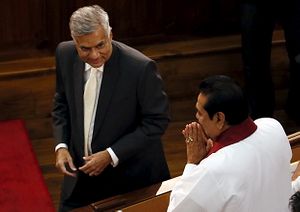Sri Lankan voters have snubbed former President Mahinda Rajapaksa for the second time in months. On January 8, Rajapaksa was ousted from power in the presidential election, an upset that denied him a third term as the island’s president. And now, in parliamentary elections held earlier this month, voters have quashed his hopes of returning to power as prime minister.
Although voters gave neither of the two main coalitions, the United National Party (UNP)-led United National Front for Good Governance (UNFGG) and the Sri Lanka Freedom Party (SLFP)-led United People’s Freedom Alliance (UPFA), an outright majority, the UNFGG emerged as the single largest group from the August 17 elections, with 106 seats in the 225-seat parliament. The UPFA, whose campaign Rajapaksa spearheaded, was relegated to second place.
Accordingly, UNP chief Ranil Wickremesinghe was sworn in as prime minister on August 21. Wickremesinghe has held the post since January, following his appointment by Sri Lanka’s new President Maithripala Sirisena.
“For now, Rajapaksa will have to be content with functioning only as a member of parliament (MP) representing Kurunegala constituency,” an SLFP parliamentarian who spoke to The Diplomat on condition of anonymity said.
Rajapaksa’s fall was as spectacular as his rise.

































